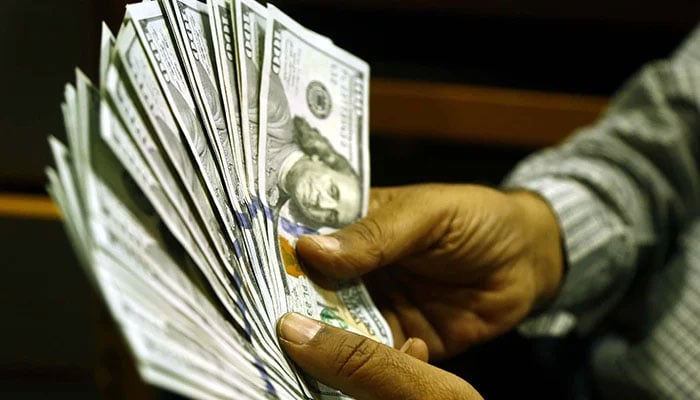Bank deposits rise 18% year-on-year on high rates, currency crackdown
KARACHI: Bank deposits increased to Rs26.398 trillion in October, up 18 percent from a year earlier, as savers flocked to take advantage of the highest interest rates in Asia, data from the central bank showed on Friday.
On a monthly basis, however, deposits in the banking industry increased slightly by 0.3 percent from Rs26.318 trillion in September, according to the State Bank of Pakistan (SBP).
Analysts attributed the increase in deposits to several factors, including higher interest rates that encouraged savers to keep their money in bank accounts, remittance growth from overseas workers, and rapid branch expansion of some banks.
"The deposit growth is also due to the conversion of foreign currencies into rupees and holding them in banks rather than at home following the government's September crackdown on the illegal currency trade and dollar smuggling," an analyst said.
"Another reason is that the increase in interest rates encouraged savers to keep their money in bank accounts, as evidenced by the rising average rate of return on deposits."
Remittance growth also boosted deposits. In October, remittances from Pakistani workers overseas increased to $2.5 billion, up 12 percent from the previous month. Moreover, the rapid branch expansion of some banks contributed to the increase in deposits.
Analysts anticipate that the remarkable growth in deposits will drive banks' earnings in the coming months even if the interest rates fall.
The country's government's need for borrowing, currency devaluation, and inflation forecasts will all continue to affect interest rates. The market had previously predicted that interest rates would stay at 22 percent until the first quarter of 2024.
However, a significant decline in the yields on Pakistan's Investment Bonds this week, spurred by hopes that inflation would decline sooner than expected, suggests the SBP may be able to lower rates in its upcoming monetary policy review, which is scheduled for next month.
Bank advances increased by 8 percent year-on-year to Rs11.898 trillion in October. Banks' investment rose 27 percent year-on-year to Rs23.232 trillion in October.
Banks' investment-to-deposit ratio (IDR) increased to 88 percent in October from 81.6 percent a year ago. However, the advance-to-deposit ratio (ADR) of the banks fell to 45.1 percent in October from 49.3 percent in the same month last year.
Analysts said that because banks are making more money from government securities like bonds and treasury bills due to their more attractive yields, banks' IDR ratio is rising.
Nonetheless, banks claim that because of the increasing borrowing needs of the government, they lend it money through investment in treasury bills and bonds.
The SBP on Friday injected a staggering Rs4.65 trillion into banks through an open market operation for 28 days. This infusion of liquidity comes at a rate of return of 22.05 percent. The SBP injected funds to save the market from a shortage of liquidity.
The broad money (M2) growth decelerated to 12.9 percent as of end-September from 14.2 percent at end-June 2023, primarily due to continued slowdown in private sector credit and more than seasonal retirement in commodity operations financing, according to the SBP's monetary policy statement that was released last month.
Similarly, the reserve money growth has slowed down from June, which is primarily explained by a significant deceleration in the growth of currency in circulation.
Since June, the Net Foreign Assets (NFA) of SBP and the banking system expanded owing mainly to significant FX inflows in July, while Net Domestic Assets (NDA) contracted, leading to an improvement in the composition of both M2 and reserve money.
-
 Harry Styles Excites Fans As He Announces Release Date Of New Song
Harry Styles Excites Fans As He Announces Release Date Of New Song -
 Japan’s Ex-PM Shinzo Abe’s Killer Is Set To Be Sentenced: How Much Punishment Could He Face?
Japan’s Ex-PM Shinzo Abe’s Killer Is Set To Be Sentenced: How Much Punishment Could He Face? -
 Prince Harry, Meghan Markle’s Return To UK Could Create Royal Family Dilemma
Prince Harry, Meghan Markle’s Return To UK Could Create Royal Family Dilemma -
 Prince Harry Turns Troubled With No Sense Of Home: ‘Isolation Is Getting To Him Mentally’
Prince Harry Turns Troubled With No Sense Of Home: ‘Isolation Is Getting To Him Mentally’ -
 Vitamin D Link To Respiratory Diseases Will Shock You
Vitamin D Link To Respiratory Diseases Will Shock You -
 A$AP Rocky Gives His Take On Children's Budding Personalities
A$AP Rocky Gives His Take On Children's Budding Personalities -
 Elijah Wood On Return To 'Lord Of The Rings' Universe
Elijah Wood On Return To 'Lord Of The Rings' Universe -
 Princess Beatrice, Eugenie Resort To Begging Sarah Ferguson: 'It'll Bring Disaster For The Whole Family'
Princess Beatrice, Eugenie Resort To Begging Sarah Ferguson: 'It'll Bring Disaster For The Whole Family' -
 Jenny Slate Hails Blake Lively Amid Lawsuit Against Justin Baldoni
Jenny Slate Hails Blake Lively Amid Lawsuit Against Justin Baldoni -
 Sophie Wessex Shares 'frustration' From Early Days In Royal Family
Sophie Wessex Shares 'frustration' From Early Days In Royal Family -
 Jason Momoa's Aquaman Unseen Snap Revealed
Jason Momoa's Aquaman Unseen Snap Revealed -
 Prince Harry Taught Only Way King Charles 'will Take Him Seriously'
Prince Harry Taught Only Way King Charles 'will Take Him Seriously' -
 Meghan Markle’s Reaction To UK Talks With Prince Harry Comes To The Forefront: ‘Leaving Me?’
Meghan Markle’s Reaction To UK Talks With Prince Harry Comes To The Forefront: ‘Leaving Me?’ -
 Taylor Swift Slams Justin Baldoni In Explosive Text Messages, Court Filing Reveals
Taylor Swift Slams Justin Baldoni In Explosive Text Messages, Court Filing Reveals -
 Blake Lively’s Drops New Allegations Against Justin Boldoni About Birth Scene
Blake Lively’s Drops New Allegations Against Justin Boldoni About Birth Scene -
 Andrew's Reasons For Giving Sarah Ferguson A Rent-free Home For 30 Years After Divorce Finally Finds An Answer
Andrew's Reasons For Giving Sarah Ferguson A Rent-free Home For 30 Years After Divorce Finally Finds An Answer




